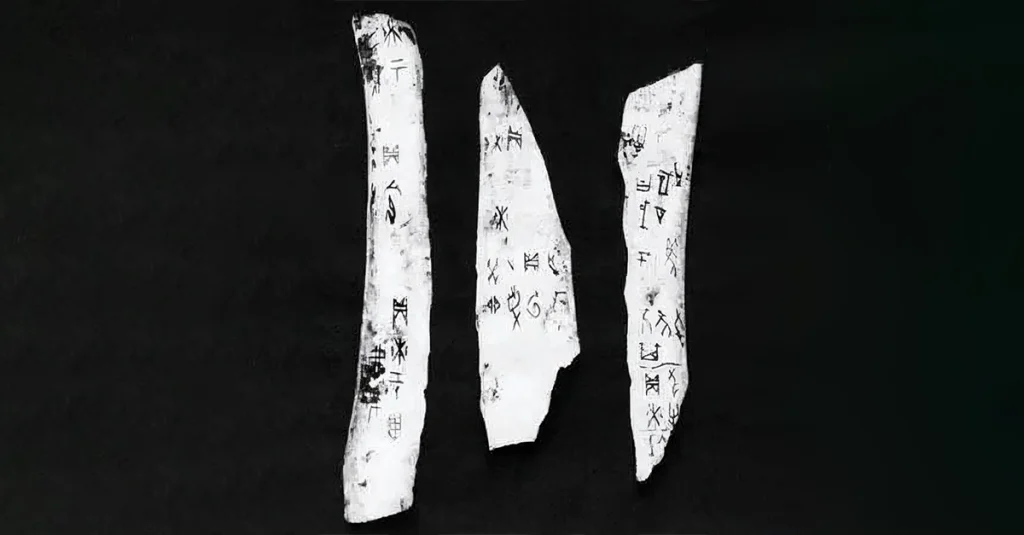China powers nearly one-fifth of the global economy, and it’s easy to see why brands dream of making it big there. But dreams can quickly turn costly.
A single mistranslated slogan or poorly chosen character has sunk campaigns and cost foreign firms millions.
The key to avoiding those mistakes is understanding yesterday. Chinese has roots that stretch back thousands of years to the Sino-Tibetan language family, and those layers of history still shape how words land with modern audiences. Knowing how Old Chinese evolved, which characters carry subtle cultural weight, and why certain terms resonate emotionally can mean the difference between sounding authentic and sounding tone-deaf.
In this blog, we’ll explore how the Chinese language history—from its Old Sino-Tibetan roots to today’s modern forms—can guide brands in choosing words and messages that truly resonate.

From Bones to Branding: What Ancient Chinese Scripts Teach Us About Design
When we think about branding today, we talk about fonts, logos, and visual identity. But believe it or not, the roots of that obsession with how words look go all the way back to ancient China—literally carved into bones.
Oracle Bone Script: Commerce Carved in Bone

The earliest form of Chinese writing—Oracle Bone Script—was etched into turtle shells and ox bones over 3,000 years ago. Many of these symbols documented decisions about farming, warfare, and trade.
They were records of commerce and survival, showing us that even in ancient times, communication was deeply tied to resource management and economic planning. In a way, they were the first brand documents—etched in bone instead of paper.
Seal Script: Where Writing Becomes Art
Jump ahead a few centuries, and writing begins to take on a more elegant, stylized form. Enter Seal Script—a squarish, flowing style popularized during the Qin dynasty. It was still functional but also beautiful, used on official seals and inscriptions.
Unlike the rugged shapes of Oracle Bone Script, Seal Script feels curated—almost like calligraphy. That transition marks a turning point: writing wasn’t just about saying something clearly, it was about saying it beautifully.
Typography Carries Emotion, History, and Identity

When you step back and look at the evolution from Oracle Bone Script to Seal Script, you start to notice something deeper than just a change in shape. You see intention. Identity. A shift from raw survival messaging to carefully crafted expression. And that’s exactly where typography still lives today.
In branding, type is about resonance. The jagged, primal lines of Oracle Bone Script hold a different energy than the refined, symmetrical flow of Seal Script. One whispers of ancient rituals and grit; the other signals harmony, structure, and power. That same emotional spectrum lives in every typeface we choose on modern packaging, websites, or logos.
Every script tells a story, and when we borrow from those ancient forms—consciously or not—we’re still using language the same way our ancestors did in order to connect on a deeper level.
Classical to Vernacular: Literature & Linguistic Shifts
Let’s take another quick leap forward—this time into the world of language sound and accessibility—so you can see how language evolution shapes both poetry and everyday connection.
Sound Changes in Middle Chinese Phonology – Why Rhymes and Slogans Age Differently
Think back to ancient rhyme schemes—poets carefully crafted lines that rhymed beautifully… but if you tried to recite those today, they’d often sound awkward or clash. That’s because Middle Chinese phonology—the sound system used by the literate class around the 6th century—had a set of initials, finals, and four tone classes (level, rising, departing, entering) that don’t match how Mandarin or Cantonese sound today.
What’s fascinating is how this evolved: as dialects shifted and syllables simplified, rhymes that once aligned perfectly no longer sounded paired—so slogans, poems, even jingles from centuries ago would be unrecognizable to modern ears. It’s a great reminder that what works in one era—sonically—might fall flat in another.
The Baihua Movement – Making Language Inclusive
Now, fast forward to the early 20th century. China was deeply rooted in Classical Chinese—a style elegant and concise, but also exclusive, like how Latin was used in elite circles.
Enter the Baihua movement—championed around 1917 by thinkers like Hu Shi—which embraced a vernacular written Chinese. Suddenly, literature, newspapers, textbooks, and public writing became clear, conversational, and accessible to everyday readers.
What happened next was remarkable: literacy soared. Hundreds of novels, dozens of textbooks, magazines, and newspapers sprang up in Baihua—that meant ideas, stories, and culture could reach across society, not just into elite circles
Scripts & Standards: From Simplified Characters to Pinyin
This section is about how China made writing simpler to learn and easier to share—and how that choice still affects your SEO fields, signup forms, and SKUs today.
Why simplified characters happened
In the 1950s, Beijing pushed a sweeping script reform to make writing faster to learn and easier to use at scale. In 1956, the State Council published the Chinese Character Simplification Scheme, notably listing 515 simplified characters and 54 components, as part of a broader literacy and language modernization drive. Contemporary state remarks framed simplification as a way to speed children’s education, fight illiteracy, and improve everyday writing—very practical goals that paired politics with pedagogy.
Pinyin: the quiet infrastructure behind search boxes and SKUs
Hanyu Pinyin—the romanization based on the Beijing dialect—was built to teach pronunciation and to standardize how names appear in Latin letters. It’s now the international standard (ISO 7098, 1982; updated 2015) and is recognized across the UN system for geographic names—so it’s what global databases, maps, and catalogs expect.
It also underpins everyday text input: most users type pinyin on a standard keyboard and let the IME convert it to characters.
Why you care (practically):
- SEO & URLs: Romanized product names, categories, and slugs index cleanly across global platforms; pinyin gives you a predictable, standards-aligned spelling. ISO
- Forms & CRMs: Latin-letter fields (shipping, loyalty, support) need consistent spellings for deduping and search—pinyin provides that backbone.
- SKUs & catalog ops: When characters aren’t allowed in codes, pinyin keeps naming systematic and sortable across regions.
Dialects & Phonology: A Multi-Voiced Market
China is one market with many voices—and the smartest campaigns use that to their advantage.
Mandarin for scale, Cantonese for local cut-through
If you’re running a nationwide campaign, Mandarin (Putonghua) is the amplifier. By 2020, 80.72% of China’s population could speak Mandarin, thanks to decades of standardization—so it travels cleanly across platforms, provinces, and national media buys.
But in Guangdong and Hong Kong, Cantonese is the heartbeat. In Hong Kong’s 2016 by-census, about 89%of residents aged 5+ spoke Cantonese at home—so audio ads, VO, and on-street activations land faster when they’re voiced in Cantonese (often with Traditional Chinese on screen).
Wu (Shanghai) context: what history tells your localization
Wu Chinese—the family that includes Shanghainese—covers the Yangtze River Delta and accounts for ~85 million speakers (c. turn of the 21st century). It’s phonologically distinct (e.g., voiced obstruents and robust tone-sandhi patterns), which shapes how lines sound in VO and how word choices “feel” on-air.
In Shanghai, keep Mandarin for reach, but weave Wu-flavored phrasing or references into OOH, radio, and social shorts when you want local warmth without sacrificing legibility.
Tones Can Trip Your Slogan
- Mandarin carries four tones (plus a neutral).
- Cantonese has six phonemic tones in Hong Kong usage (traditionally “nine” when counting checked tones). What rhymes—or even reads cleanly—in Mandarin can mis-rhyme or change meaning in Cantonese.
- Shanghainese (Wu) applies tone sandhi that can reshape tones across a phrase—so literal transfers of timing and melody from Mandarin VO can feel “off.”
Plan market rollouts by studying Chinese-speaking countries around the world.
20th-Century Language Reform & Policy
The PRC’s reform playbook: cohesion first
From the 1950s onward, Beijing moved to make a vast country easier to teach, govern, and connect. In 1956, the State Council released the Chinese Character Simplification Scheme—a foundational list that formalized hundreds of simplified forms and components, making characters faster to learn and write.
The push didn’t stop there. The Law on the Standard Spoken and Written Chinese Language (adopted 2000, effective 2001) established Putonghua and standardized characters as the national norm—especially in education—cementing a single linguistic baseline for public life.
By 2020, the result was visible: 80.72% of China’s population could speak Mandarin, up 27.66 percentage points since 2000—a huge lift for nationwide campaigns and mass media.
Cultural Revolution language: a style that still echoes
The Cultural Revolution (1966–76) standardized a political vocabulary and an unmistakable slogan style—terms like “worker-peasant-soldier” and exhortative phrasing that bled into everyday discourse and popular media.
Many of those coinages and cadences linger in public memory, even as their meanings have shifted with time.
Campaigns of the era also targeted the “Four Olds” (old ideas, culture, customs, habits), reinforcing a preference for direct, mass-address language over elitist Classical phrasing—a tone that still shapes how “serious” vs. “folksy” copy is heard.
Schools, smartphones, and why young consumers default to Simplified + Pinyin
Because the national education mandate centers on Putonghua and standardized characters, students grow up reading Simplified and learning pronunciation through pinyin.
On their phones and laptops, that habit becomes infrastructure: most people type Chinese by entering pinyin and letting the IME convert it to characters, and Sogou Input Method alone has been reported to serve about 70% of Chinese input-method users (hundreds of millions of MAU).
Business Takeaways & Localization Best Practices
When you understand how Chinese evolved (from Old Chinese and seal-script aesthetics to Baihua, Simplified, pinyin, and dialect realities), you choose words, rhythms, and visuals that hit the right cultural notes.
What to do next (the AsiaLocalize way):
- Match script to market. Use Simplified for Mainland, Traditional for Hong Kong/Taiwan; sanity-check typography so the vibe (heritage vs. modern) fits the product story.
- Plan for dialect in audio. Keep Mandarin for scale; adapt VO/taglines for Cantonese or Wu where it drives recall.
- Treat pinyin as infrastructure. Standardize pinyin spellings across URLs, on-site search, forms, and SKUs to keep ops clean and SEO consistent.
- Localize tone, not just terms. Borrow the right register—vernacular when you want warmth and reach; classical/heritage cues when you want gravitas.
- Pre-test for sound. Rhymes and taglines that sing in one variety can clash in another; run quick in-dialect tests before you lock creative.
For flawless product literature, explore our Chinese translation services.





